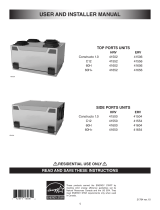
2
ABOUT THIS MANUAL
Congratulations!
You have made an excellent choice!
The operating principle of your Heat Recovery Ventilator will protect your house and give
you personal comfort you have never known before.
We have prepared this User Manual especially for you. Please read it carefully to ensure
you obtain full benefit from your Heat Recovery Ventilator unit. Over the coming months,
you will increasingly appreciate the feeling of living in a more comfortable house.
Please take note this manual uses the following symbols to emphasize particular
information:
NOTE: Indicates supplementary information needed to fully complete an instruction.
We welcome any suggestions you may have concerning this manual and/or the unit,
and we would appreciate hearing your comments on ways to better serve you. Please
forward all correspondence to us at the address indicated on the product registration
card included with this manual.
Identifies an instruction which, if not followed, might cause serious personal
injuries including possibility of death.
CAUTION
Denotes an instruction which, if not followed, may severely damage the unit
and/or its components.
WARNING
!
CAUTION
Make sure at all times that the outside hoods are free from any snow during the
winter season. It is important to check your unit during a big snow storm, so it
doesn’t draw any snow. If this is the case, please operate the unit in recirculation
mode, or OFF mode, for a few hours.
Do not use your HRV during construction or renovation of your house or when
sanding drywall. This type of dust may damage your system.
Since the electronic control system of the unit has a microprocessor
incorporated, it may not operate correctly because of the external noise or very
short power failure. If this happens, unplug the unit and wait approximately
10 seconds. Then, plug the unit in again.
CAUTION
When leaving the house for a long period of time (more than two weeks), a
responsible person should regularly check if the unit operates adequately. If
the ductwork runs through an unconditioned space (e.g.: attic), the unit must
operate continuously except when performing maintenance and/or repair. Also,
the ambient temperature of the house should never drop below 18°C (65°F). At
least once a year, the unit mechanical and electronic parts should be inspected
by qualified service personnel.


















